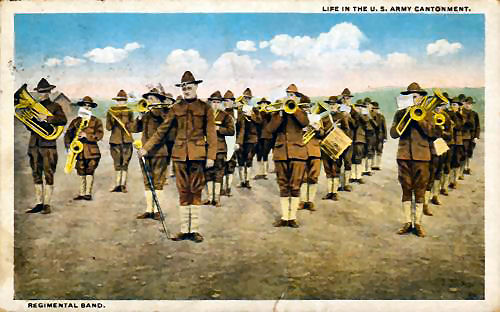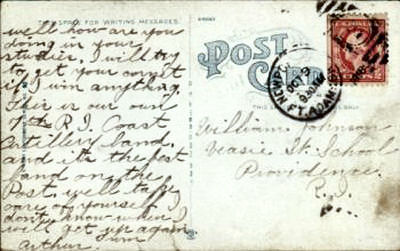![]()
Postal History Introduction
Stampless
Covers
1846
to 1900 Issues
1901-1950
Issues
1951-2003
Issues
Cancels
&
Miscellaneous
Postal
Stationery
Post
Cards
Air
Mail
First
Day &
Event Covers
Parcel Post/Special Delivery
Registered & Official Mail
Commercial & Advertising
Revenue & Postage Due
Wildlife & Game Issues
Complete List of RI Issues
|
Rhode Island Picture
Post Cards |
|
|
|
|
|
|
Post
Card Message Reproduced Below: Fort Adams is the largest coastal fortification in the United States. Prior to and during the Revolutionary War there were several fortifications erected on Goat Island. These included Fort Anne (War of the Spanish Succession), Fort George (1730 - renamed Fort Liberty in 1776), Fort Chastellux (1779 - On Hallidon Hill by the French overlooking the old fortifications), Fort Washington (Old Fort Liberty renovated in 1784), and Fort Wolcott (1800 -Fort Washington renovated and renamed). Major Louis Tousard, the French officer who had completed the renovation of Fort Walcott also constructed another fortification at Old Brenton's Point on Goat Island of twenty guns covering the East Passage and another twenty guns covering Newport. The New fortification was dedicated on July 4, 1799 and christened Fort Adams in honor of President John Adams. In 1817, President James Monroe, who was determined that a future enemy could not repeat the destruction that occurred in Washington, DC during the War of 1812, recommended that the entire United States Coastal Fortification System be upgraded and improved. Construction began on an improved version of Fort Adams in 1824. The old fort was razed to the ground, however the name Fort Adams was retained. Construction on the new fort continued until 1857. The new Fort Adams was a massive stonework built in the shape of an irregular pentagon and originally equipped with carronades and smooth bore muzzleloaders. In 1862, the fort was rearmed with the new Rodman rifled cannon; 10-inch guns in casemates and 15-inch guns in open batteries on top of the southwest bastion. In response to the Spanish American War of 1898, improvements were finally undertaken for Fort Adams late in that year. Four gun batteries, including one with two 10 inch disappearing guns and two batteries of 12 inch mortars were added to the fort at this time. During World War II, new forts with longer range guns were constructed at Beaver Tail, Point Judith, Sakonnet Point, and Fort Varnum in Narragansett, which contained four fire control stations for the other forts. Fort Adams was relegated to a second tier status during World War II, although it remained the headquarters of the Harbor Defense Command. Fort Adams was officially deactivated in June 1950 under the command of Major B. H. Schimmel. In 1953 the fort was turned over to the Navy, which used it as a storage facility and also occupied the old officer's quarters. In 1958 and 1960, President Eisenhower used the former Commanding Officer's quarters during his summer vacation in Newport. The Navy donated the property to the State of Rhode Island in 1965 for use as a State Park and on September 4, 1972 the fort was opened to the public. The fort was designated as a National Historic Landmark in 1976, however the fort was closed to the public in 1980 over budget and safety concerns. Fort Adams was reopened in 1995 and today the fort is open to the public from May through October and is home to the Newport Folk Festival, Jazz Festival and Arts Festival |
![]()
RI Historical Society
The Post Offices
Home Page
RI Tercentenary Issue History
RI Philatelic Society
Recently Added Pages
Philatelic Primer
Rhode Island Around the World
Rhode Island
Town Postmarks
Other Websites of Interest

